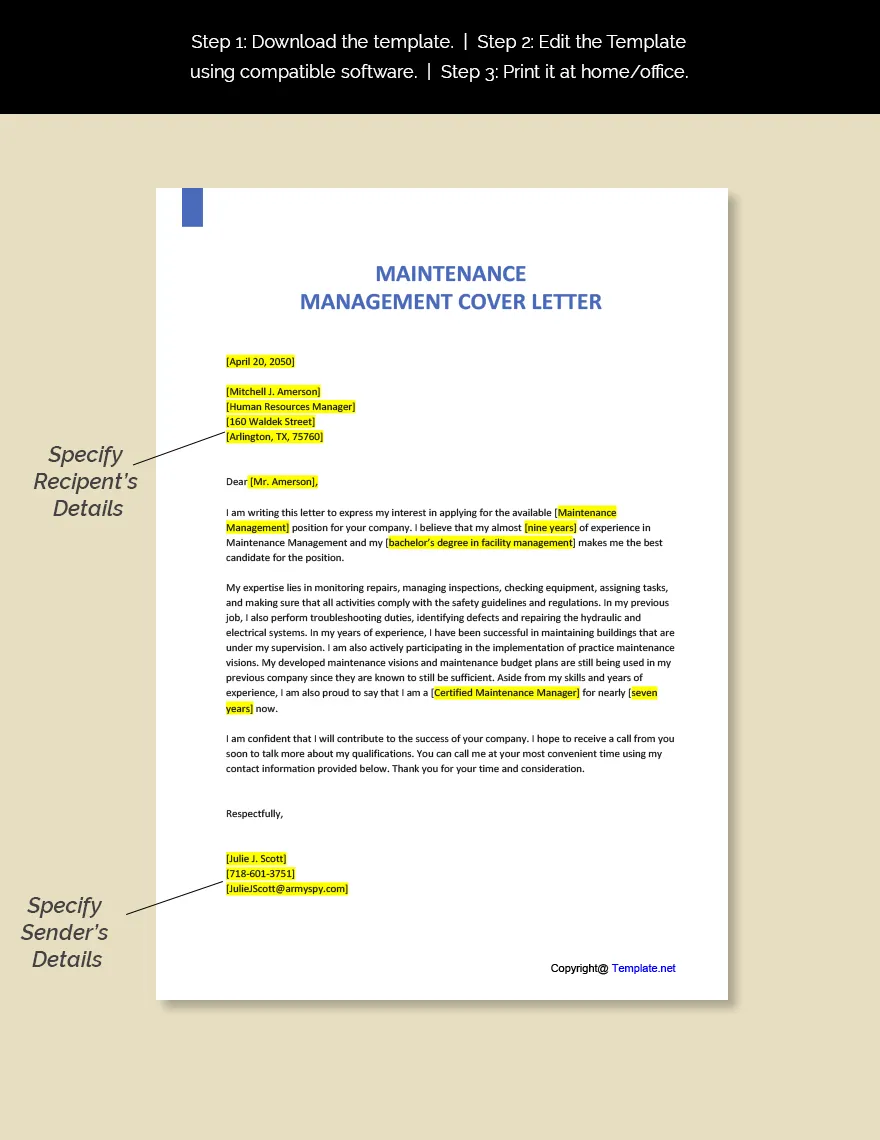A well-crafted maintenance job cover letter is your first opportunity to impress a potential employer and secure an interview. It’s more than just a formality; it’s a crucial tool to showcase your skills, experience, and passion for the role. A compelling cover letter complements your resume, providing context and personality that help you stand out from other candidates. In a competitive job market, a perfect cover letter can be the difference between getting hired and being overlooked.
Understand the Purpose of a Cover Letter
The primary purpose of a cover letter is to introduce yourself and your qualifications to a potential employer. It’s a chance to explain why you’re the ideal candidate for the specific maintenance job. Unlike your resume, which provides a factual summary of your career, a cover letter allows you to tell a story, connect your skills to the job requirements, and demonstrate your enthusiasm. It demonstrates your written communication skills and ability to express yourself clearly and concisely. The cover letter also helps you to personalize your application, showing that you’ve taken the time to understand the company and the role.
Highlight Relevant Skills and Experience
Your cover letter is your chance to shine a spotlight on the skills and experience that make you a strong candidate for the maintenance position. This section should mirror the job description, emphasizing the skills that the employer specifically seeks. Don’t just list your skills; provide examples of how you’ve used them in previous roles. Use clear, concise language and avoid jargon that the reader might not understand. Show, don’t just tell, by providing concrete examples of your accomplishments and contributions.
Identify Key Skills for Maintenance Roles
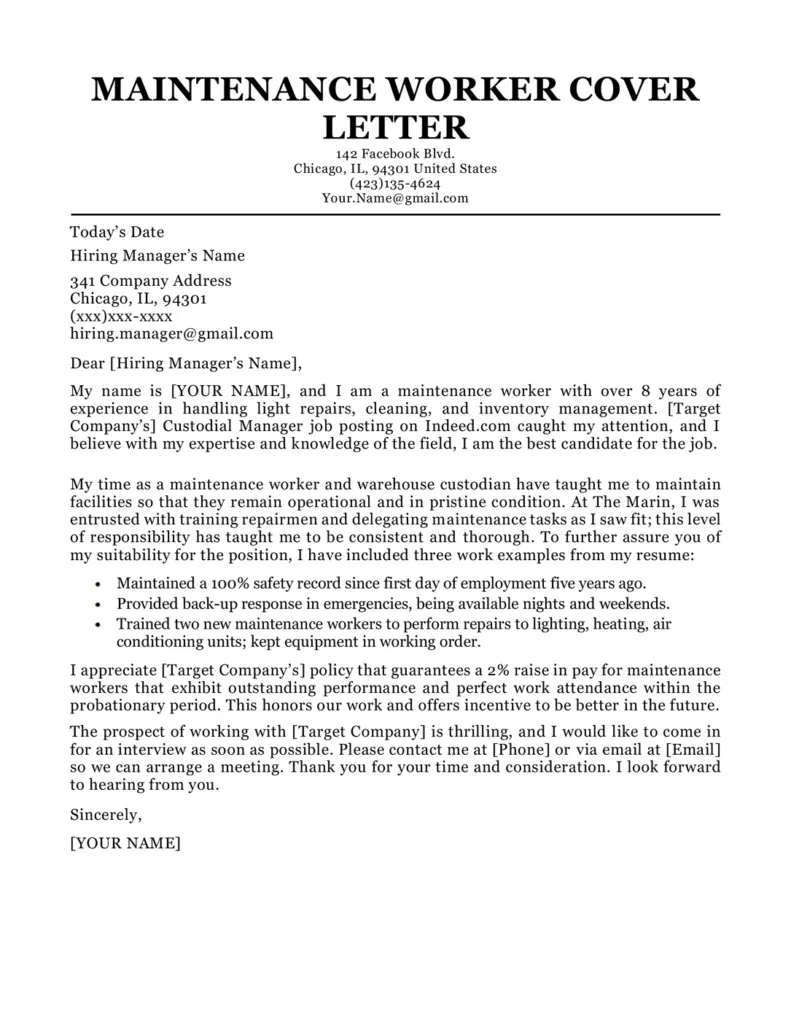
Maintenance roles require a diverse set of skills, including technical proficiency, problem-solving abilities, and communication skills. Key technical skills often include knowledge of plumbing, electrical systems, HVAC, carpentry, and other trades. Problem-solving is essential for diagnosing and repairing equipment efficiently. Communication skills are vital for interacting with colleagues, supervisors, and clients. Other important skills include attention to detail, physical stamina, and the ability to follow safety protocols. Make sure your cover letter highlights these skills to match the job description.
Detail Your Maintenance Experience
When detailing your maintenance experience, be specific about your responsibilities and achievements. Mention the types of equipment you’ve worked with, the size and scope of the facilities you’ve maintained, and the types of maintenance you’ve performed (preventive, corrective, etc.). Quantify your accomplishments whenever possible. For example, “Reduced downtime by 15% through proactive maintenance” or “Managed a team of 5 maintenance technicians.” Providing concrete examples of your past performance will show the employer the value you can bring to their organization.
Tailor Your Cover Letter to the Job Description
Generic cover letters often fail to make a strong impression. Tailoring your cover letter to each specific job application is essential to demonstrate your interest and qualifications. Carefully review the job description and identify the key requirements and responsibilities. Then, customize your letter to address those specific needs. This shows the employer that you’ve taken the time to understand their needs and that you’re a good fit for the role. Your ability to adapt and showcase the right experience is vital to getting noticed.
Analyze the Job Requirements
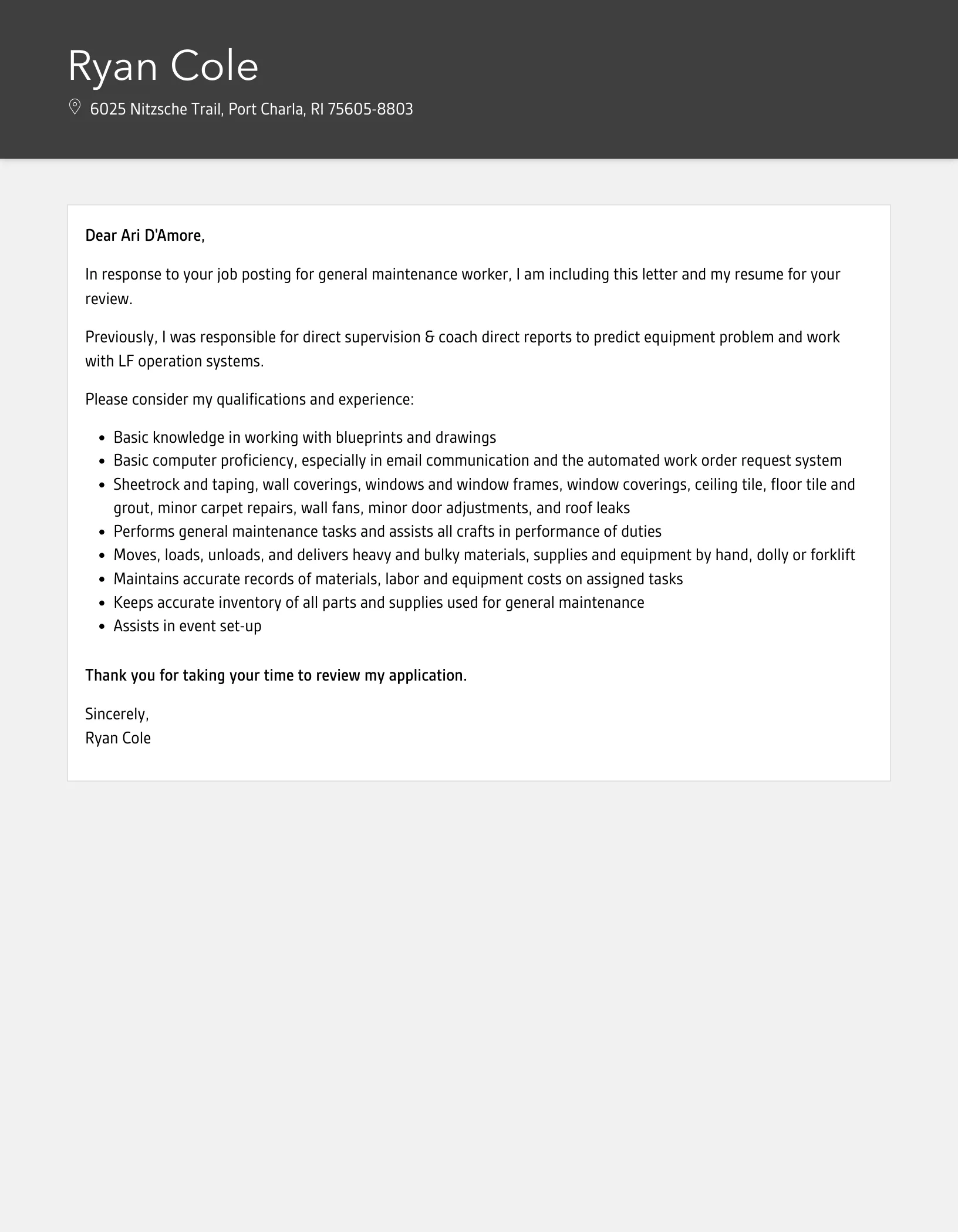
Before writing your cover letter, thoroughly analyze the job description. Identify the essential skills, experience, and qualifications the employer is seeking. Look for keywords and phrases that you can incorporate into your letter. Take note of the specific tasks and responsibilities mentioned in the job description. Understanding the requirements enables you to focus your letter on the most relevant aspects of your background and skill set.
Customize Your Letter
Once you’ve analyzed the job description, customize your cover letter to highlight your relevant skills and experience. Use the keywords and phrases from the job description to demonstrate your alignment with the requirements. Provide examples of your accomplishments that directly relate to the job responsibilities. This level of customization demonstrates your interest and makes your application stand out. Ensure your tone and style match the company’s culture, showing that you’ve done your research.
Showcase Your Achievements
Employers want to know what you’ve accomplished in previous roles, not just what you’ve done. Your cover letter should highlight your achievements, demonstrating your ability to deliver results. Focus on the positive impact you’ve made in previous positions. Use the STAR method (Situation, Task, Action, Result) to describe your achievements. This structured approach helps you provide clear and compelling examples of your accomplishments, making your letter more impactful.
Quantify Your Accomplishments
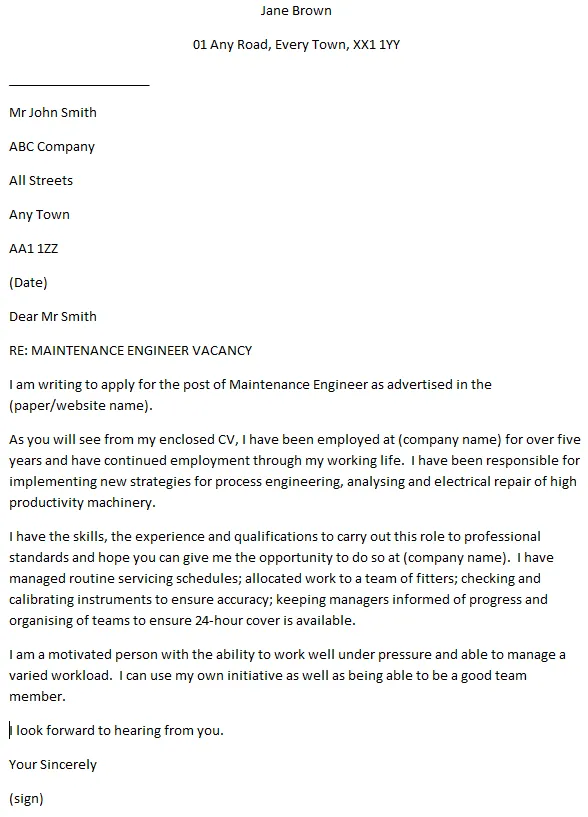
Whenever possible, quantify your achievements. Use numbers and data to provide concrete evidence of your accomplishments. For example, instead of saying “Improved efficiency,” say “Improved efficiency by 20%.” Quantifiable achievements are more persuasive and demonstrate the value you brought to previous employers. Use metrics such as cost savings, reduced downtime, increased productivity, or improved safety records to showcase your success.
Use Action Verbs to Describe Your Achievements
Action verbs make your cover letter more dynamic and engaging. Start each bullet point or paragraph describing your achievements with a strong action verb. Examples of effective action verbs include “managed,” “implemented,” “improved,” “reduced,” “maintained,” “repaired,” “developed,” and “achieved.” These verbs make your accomplishments more vivid and show that you are a proactive and results-oriented individual. Using action verbs helps you create a more compelling narrative that captures the reader’s attention.
Demonstrate Your Passion and Enthusiasm
Employers want to hire candidates who are genuinely interested in the role and the company. Your cover letter should demonstrate your passion for maintenance and your enthusiasm for the specific opportunity. Show that you’ve researched the company and understand its mission and values. Your enthusiasm can make a lasting impression and make you stand out from candidates who may simply be looking for a job.
Express Your Interest in the Company
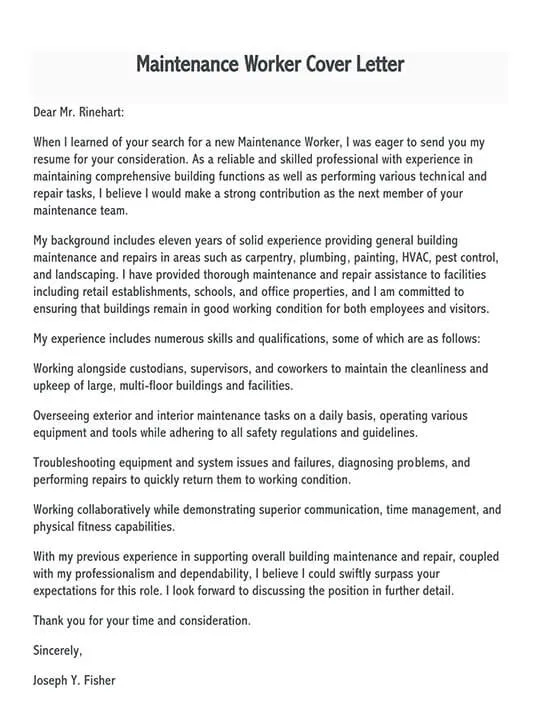
Before writing your cover letter, research the company. Understand its mission, values, and recent projects. Mention something specific that interests you about the company or the role. This shows that you’ve taken the time to learn about the organization and are genuinely interested in working there. Demonstrate that you align with the company’s goals and values, showing a proactive approach to getting hired.
Show Your Understanding of the Role
Demonstrate your understanding of the maintenance job and its responsibilities. Briefly mention what you expect your daily activities to be and how you plan to contribute. Explain how your skills and experience align with the role’s requirements. This shows that you have a clear grasp of the job and are ready to hit the ground running. Highlight specific tasks and challenges you are prepared to handle and show you are proactive.
Proofread and Format Your Cover Letter
A well-formatted and error-free cover letter is essential for making a professional impression. Proofread your letter carefully to catch any grammatical errors or typos. Use a clean, easy-to-read format that’s appropriate for professional correspondence. Poor formatting and errors can undermine your credibility, so take the time to ensure your cover letter is polished and professional.
Check for Grammatical Errors and Typos
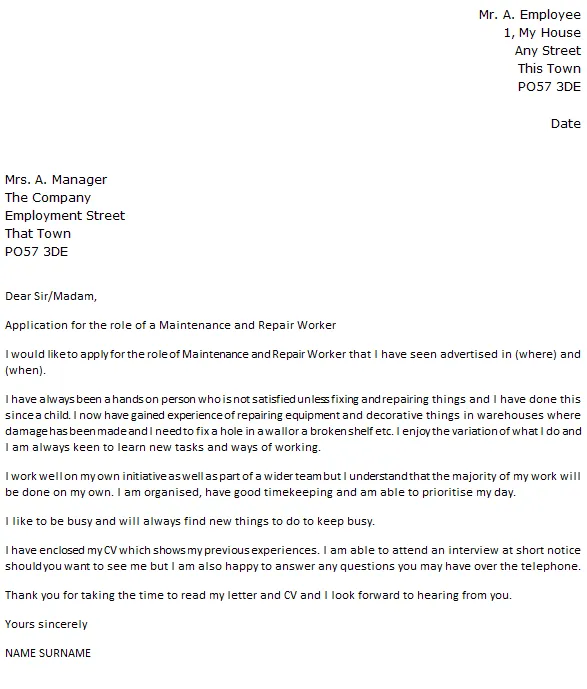
Typos and grammatical errors can reflect poorly on your attention to detail and professionalism. Proofread your cover letter multiple times. Use a grammar checker and ask a friend or family member to review your letter. Pay close attention to spelling, punctuation, and sentence structure. Ensure that your letter is clear, concise, and easy to read. The fewer errors, the better the impression you will make.
Use a Professional and Easy-to-Read Format
The format of your cover letter contributes significantly to its overall presentation. Use a standard font, such as Times New Roman or Arial, with a font size between 10 and 12 points. Use appropriate margins and spacing to make your letter visually appealing. Include your contact information at the top, followed by the date, the hiring manager’s name (if known), and the company’s address. Keep your letter concise, ideally within one page. The aim is to present your information clearly, allowing the hiring manager to quickly grasp the main points.
In conclusion, writing a perfect maintenance job cover letter requires a strategic approach. By understanding the purpose of the letter, highlighting relevant skills and experience, tailoring it to the job description, showcasing your achievements, demonstrating your passion, and ensuring it is well-formatted and proofread, you significantly increase your chances of securing an interview. Remember that your cover letter is your opportunity to make a positive first impression, so invest the time and effort to create a compelling narrative. Following these guidelines will enable you to stand out in a competitive job market and ultimately land your dream maintenance job. Good luck!
